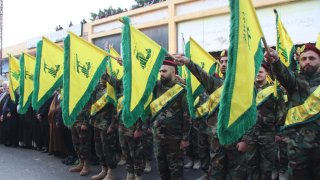North Korea’s Hezbollah Connection
North Korea has been a key supplier and facilitator of Hezbollah’s military capabilities and logistical flexibility.
As we watch Israel move into Lebanon with ground forces this week, it is important to understand that this would not be necessary unless Hezbollah had a vast network of tunnels that prevents destruction from purely air power. To destroy or degrade Hezbollah’s military ability to continue attacking Israel’s citizens, the IDF must send in land forces to attack them underground. This military paradigm shift, which started in the 2006 war, would not exist were it not for the expertise, engineering, equipment, advisors, and technicians provided by North Korea. Now we see it in action thanks to North Korean military proliferation and Hezbollah’s unending appetite for launching rockets into towns in northern Israel.
Numerous reports following the 2006 Israel-Hezbollah war provide evidence that Hezbollah’s underground facilities were constructed under North Korean supervision and advising in 2003–2004. The tunnels contained, among other things, dispensaries, arms dumps, and food stocks. This significant tunnel network was far more robust than Israeli forces anticipated as they prosecuted combat operations against Hezbollah in 2006. To quote an article in the Israeli press, “Hizbullah’s military bases, armories, bunkers and communications networks were much more extensive than Israel’s intelligence services estimated on the eve of the 2006 war.” Other reporting based on testimony from a former IRGC officer states, “With the assistance of several Iranian engineers and technicians, as well as North Korean experts, who traveled to Lebanon disguised as servants for the Iranian embassy and its officers, Hezbollah has successfully built a 25km long underground belt, with 12-meter openings along it, the officer added. Every four openings are connected to one another through an easily accessible passageway.” However, the system Hezbollah used in 2006 was only the beginning.
In 2021, a critical report from the Alma Research Center (AMC) in Israel revealed Hezbollah had built another larger tunnel system—with the assistance of the North Koreans, of course (and the Iranians). Hezbollah agreed to a $13 million deal with KOMID (North Korea’s primary proliferation front company) to build a forty-five-kilometer tunnel system connecting several key nodes in Lebanon, reportedly much longer and more sophisticated than the first tunnel system. The North Koreans had already been paid $6 million by 2014, and the tunnel system appears to have been completed by 2021. As the report explains, “In our estimation, the cumulative length of all the tunnels in the ‘Land of the Tunnels’ can reach up to hundreds of kilometers. Hezbollah tunnels, like Hamas tunnels, contain underground command and control rooms, weapons and supply depots, field clinics, and specified designated shafts used to fire missiles of all types (rockets, surface-to-surface missiles, anti-tank missiles, and anti-aircraft missiles). These shafts are hidden and camouflaged and cannot be detected above ground.”
What the evidence presented above shows us is that Hezbollah has been building up in anticipation of another conflict with Israel. Clearly, they have been enabled in this process by support from North Korea and Iran. It is also important to note that these tunnels are a key factor, perhaps the key factor, in Israel’s decision to bring ground forces into the conflict with Hezbollah in Lebanese territory. The tunnels not only give Hezbollah longer sustainment but also the ability to move forces and equipment from combat zone to combat zone without detection from IDF aircraft or other intelligence collection methods. Thus, North Korea has been a key aspect of Hezbollah’s military capabilities and logistical flexibility. There is now quite simply no other way of going after Hezbollah forces except to take out this extensive and sophisticated tunnel system—and that will take ground troops.
This is yet another example of the fact that North Korea’s fingerprints are all over the violence in the Middle East that has occurred since October 7, 2023. There is now definitive evidence that North Korea supplied Hamas with F-7 RPG’s 122mm rockets and launchers as well as other small arms. Pyongyang has supplied the Houthis with both conventional weapons and ballistic missiles, and Iran (its biggest customer) with the same—including the genesis of missile systems and engines that attacked Israel in April.
Despite a plethora of evidence, the United States government has yet to acknowledge the involvement of North Korea in the violence that is ongoing in the Middle East. The reasons for that are almost unexplainable. There has been no hesitation to address North Korea’s proliferation to Russia. But why is there no discussion of Iran, Hamas, and Hezbollah? Unless or until the United States engages in more robust enforcement of existing sanctions and publicly announces North Korea’s role in the current violence in the Middle East, Pyongyang will continue to engage in these financially lucrative, sanctions-busting activities.
Dr. Bruce E. Bechtol Jr. is a professor of Political Science at Angelo State University. He is also the president of the International Council on Korean Studies and a fellow at the Institute for Corean-American Studies. The author of five books dealing with North Korea, his latest work is entitled North Korean Military Proliferation in the Middle East and Africa.
Image: Shutterstock.com

